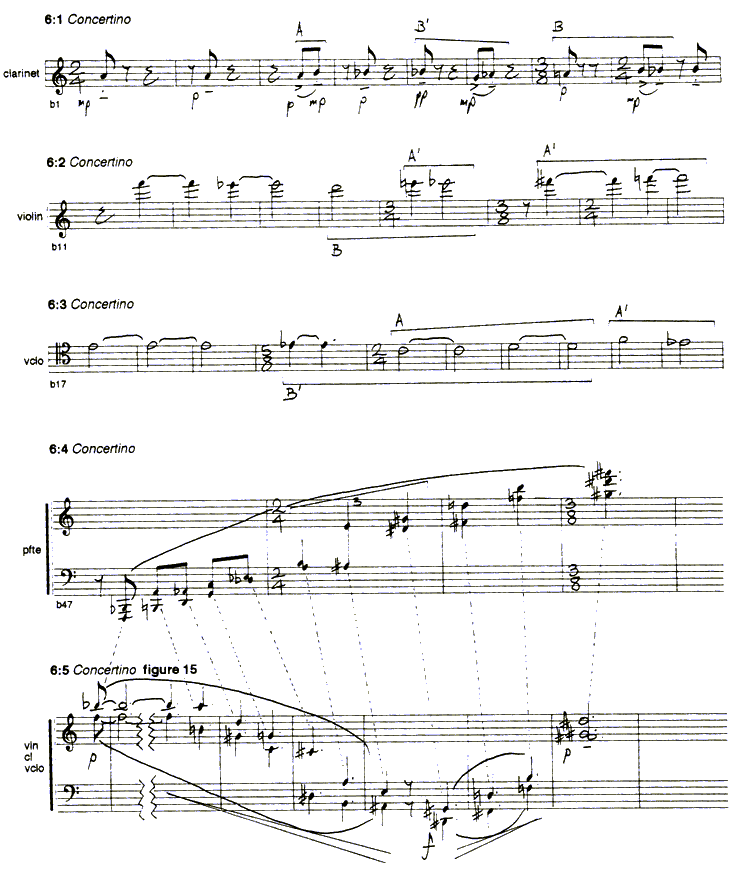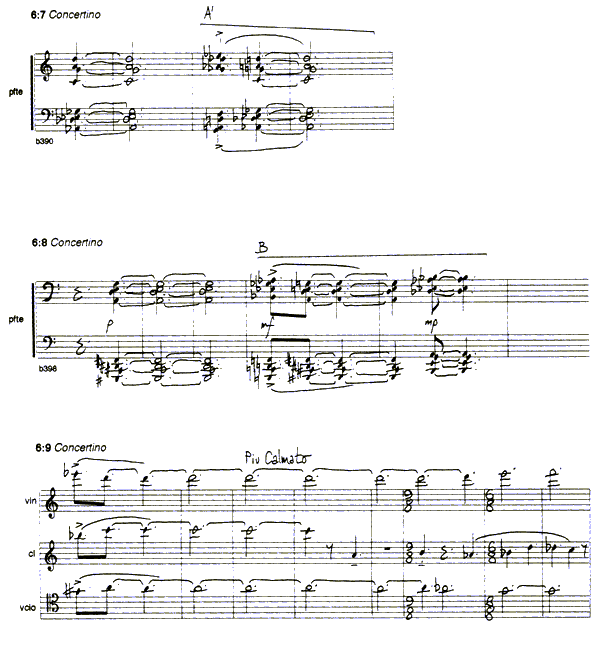rhoadley.net music research software blogs
introduction through the sharp hawthorn in principio four archetypes sextet only connect shilbottle cobbles miscellaneous pieces scena concertino three pieces for two pianos conclusions bibliography
6
Concertino
for clarinet, violin, 'cello and piano
Composed: Charterhouse, September 1988
Performed: Never
6.1 Introduction
This piece, one of the shortest in the portfolio, was written in the shortest time: about six weeks. Even so, was still too long to be considered for the Huddersfield Festival Competition, for which it was written.
The piece is to some extent a reaction to the previous two pieces I had completed: Through the Sharp Hawthorn and Only Connect, both of which had used quite complex and involved compositional methods. Although basically intuitive, they still used rows, matrices and other methods to complete the detail. After moving to Charterhouse in the Summer of 1988, I felt that I wanted to get started in the new environment as soon as possible, and so I wrote Concertino quickly and almost entirely intuitively. As such, it represents the first in a new line of pieces. Whatever the qualities of the piece, it has a confidence and assertiveness that is not present in the earlier music.
6.2 Analysis & Compositional Methods
This assertiveness is reflected in the simplicity of the material. The piece, more than any other, has a straightforward, traditional form, which, as can be seen from the graphic analysis, is essentially in sonata form. The piece, had it been selected for the Competition short-list, would have been played by professionals experienced in twentieth century music, so I decided to include concerto-like interludes for each instrument, much in the style of a nineteenth-century concerto: each instrument has it's own exposition, although these turned out to be cadenza-like rhapsodies than directly related to the tutti material.

The latter is essentially a slow introduction describing two fairly simple ideas: a meandering, chromatic clarinet line, augmented once in the violin and again in the 'cello, (ex 6:1, 6:2 & 6:3). The piano interrupts the phrase with a simple upward moving figure (ex 6:4). In a manner similar to other examples of the 'one-movement form' as described above, this process is repeated twice, each time expanding.
The pianos interruptions, which have grown in ambition on each occasion, expand into a cadenza-like passage. One by one, each instrument is 'introduced' as a soloist, each displaying typical characteristics of the instrument. At figure 13 there is a short codetta and transition, leading into the B section of the one movement form. As usual, this is formed by putting elements of the previous material into a new light and developing them into new ideas, relating these new ideas to previous ones. In this case, by figure 20, the material has worked itself around to a recapitulation, the A' section of the form. As in previous pieces, this is both more and less than a recapitulation: the lengthy repeated sections of the opening are reduced to a single, rapidly expanding version, and the previously graded piano interruptions are replaced by a single, tutti, fortissimmo outburst. Finally, an exuberant and extended coda finishes the piece off.

The B section displays a good, if simple example of how the 'development' section works. At figure 15, an apparently new idea is presented by violin and clarinet and 'cello, (ex 6:5), which is interrupted by a vigorous piano phrase, (ex 6:6). This is a development of the introductory material but in a new tempo - specifically, ex 6:5 is a transcription of ex 6:4 in a different contour (and instrumentation). The piano interruptions fulfil a similar function to those in the introduction, but the material is now derived from the previous solo material. The ex 6:5 material naturally tends, then, to the introductory material, as it does over the passages from figure 17-19, (ex 6:7, 6:8 & 6:9); and by figure 20 the transformation is complete.

6.3 Local and Global
Below is a table outlining the structure of the piece, emphasising the relationship between the local material and it's global function. It should be read in combination with the graphic analysis.
| bar | material | instrumentation |
| A - Introduction | ||
| 1-47 | I | cl, vln, vclo |
| 47-51 | chorus | piano |
| 52-72 | II | cl, vln, vclo |
| 73-84 | chorus | piano |
| 85-95 | IIIa | cl, vln, vclo |
| 96-97 | sub-chorus | pianoforte |
| 98-108 | IIIb | Clarinet, violin, 'cello |
| 109-116 | final chorus | pianoforte |
| B - | soli | accompanied by: |
| 117-157 | Pianoforte | - |
| 158-206 | Clarinet | Pianoforte |
| 207-211 | Transition | - |
| 212-231 | 'Cello | Pianoforte, clarinet |
| 232-254 | Transition | |
| 255-299 | Violin | Pianoforte with clarinet and 'cello |
| C - Codetta | ||
| 300-322 | Tutti | |
| B - Second Section | ||
| 336-454 | Tutti | |
| A' - Recapitulation | ||
| 454-519 | as 1-116 | Tutti |
| Codetta' | ||
| 520-551 | as codetta (300-322) | Tutti |
| Coda | ||
| 552-607 | Tutti | |
6.4 Meta-Global
Unlike the preceding few pieces, there is little evidence of the 'verse' theme used in Scena, Through the Sharp Hawthorn, or Only Connect (listed in ex 1:1 - 1:22). However, a particular sequence of chords used is Scena (figure MM), is used here, and is exploited strongly, (figure 20, ex 1.37). This is, in retrospect, more important as it might otherwise appear because it is symptomatic of a new approach to tonality that appears from Concertino. The previous pieces used tonality in quite an ambiguous fashion, harmonies often having little or no explicit or implicit tonality. This is especially true of Through the Sharp Hawthorn. In Concertino, chords such as those used at figure 20 are more fundamentally tonal, in that they are based on the major/minor triad ambiguity. There is considerable play made of the ambiguity caused by placing the minor third at the root of the chord as in ex 1:37a, with the major third above, and the whole further coloured by other more or less diatonic elements. The harmony can then be expanded using the simple device of contrary motion: the harmony is divided into two groups, and the two move in opposite directions. the harmony is expanded particularly at rest points, where, using entirely logical and simple methods, differing and yet related harmonies can be created, as in the rest of the passage quoted as ex 1:37.
6.5 Influences
Because of the instrumentation, the Messiaen of Quartet for the End of Time would seem to be an obvious model, but there is little or none of that composer here. There are perhaps elements of Birtwistle's Ring a Dumb Carillon in some of the rhythms and trills, but this is not particularly strong. The use of the chords with major/minor tendencies is a direct influence of Stravinsky, a composer whom I have strongly admired for some years. there are, perhaps, some hints of Bartok, too.
6.6 Judgement
This is one of the most 'basic' pieces amongst those submitted. The material is treated quite freely, and the relationships between materials are, I think, quite explicit. For the first time, I used a straightforward repeat of material, (the tutti codettas above, for instance), and there is a much greater use of standard musical gestures. I made a deliberate attempt to make the piece dramatic, with contrasts between dark harmonies and winding chromatic phrases and the exuberant codettas and especially the final coda.
Before compiling the MIDI sequence file for this piece I considered Concertino to be my least favourite of the major pieces in the portfolio, perhaps because it felt like a transitional piece, and because of the speed of composition, I felt there were many crudities of expression. However, although I still feel that some of the sounds and gestures are sometimes too harsh and crude, I found myself liking and respecting the piece more during the MIDI compilation. At least some of this may be to with the fact that, because of its highly rhythmic and percussive nature, Concertino was quite well suited to MIDI rendition, but above all, I feel it has a sense of exuberance and raw energy that is lacking from the previous highly planned pieces, and presents a new way forward to some of the later pieces, especially Three Pieces for Two Pianos.